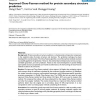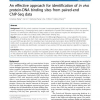294 search results - page 24 / 59 » Predicting the beta-helix fold from protein sequence data |
BMCBI
2010
13 years 7 months ago
2010
Background: Caspases are a family of proteases that have central functions in programmed cell death (apoptosis) and inflammation. Caspases mediate their effects through aspartate-...
BMCBI
2006
13 years 7 months ago
2006
Background: Protein secondary structure prediction is a fundamental and important component in the analytical study of protein structure and functions. The prediction technique ha...
ISMB
2000
13 years 9 months ago
2000
Knowing the number of residue contacts in a protein is crucial for deriving constraints useful in modeling protein folding, protein structure, and/or scoring remote homology searc...
BMCBI
2010
13 years 7 months ago
2010
Background: ChIP-Seq, which combines chromatin immunoprecipitation (ChIP) with high-throughput massively parallel sequencing, is increasingly being used for identification of prot...
BMCBI
2007
13 years 7 months ago
2007
Background: The problem of protein structure prediction consists of predicting the functional or native structure of a protein given its linear sequence of amino acids. This probl...


